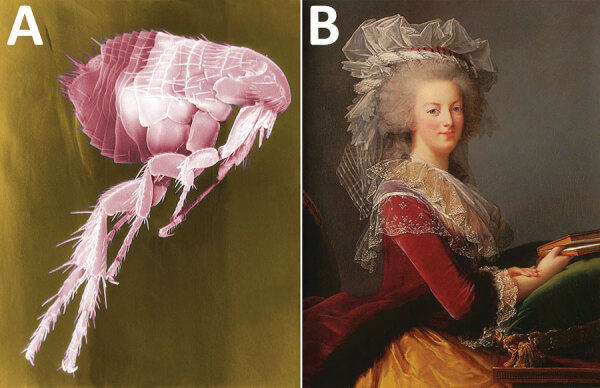Puce [pyoos]
For those with synesthesia, in whom stimulating 1 sensory pathway gives rise to a subjective sensation of a different character, the word plague may chromatically resonate with puce (Figure). In pre-revolutionary France, an era of “evocative color nomenclature,” Marie Antoinette’s reign was precipitating intense criticism. Her countrymen were experiencing severe socioeconomic stress, thus her sartorial self-indulgence was much resented.
Figure.

A) Digitally colored scanning electron microscopic image of a flea. Puce is a particularly difficult color to describe. Numerous shades of puce exist, some of which are associated with different anatomic areas of the flea. Image no. 11436: Janice Haney Carr/CDC. B) Portrait of Marie Antoinette painted in 1785 for the Ministry of Foreign Affairs, by Louise Élisabeth Vigée Le Brun. Private collection, Public domain. She seemed to have “preferred a shade leaning more toward ash-gray,” but is seen here modeling a more standard hue of puce.
After discovering the Queen wearing a new gown, her husband, Louis XVI, the King of France, chided her, describing the dress’s unflattering purple‒brown hue as “couleur de puce” (color of fleas). This admonishment had the unintended consequence of promoting puce as the exclusive color worn by the French court. Puce, the French word for flea, descends from pulex (Latin). Flea droppings leave puce colored “bloodstains” on bedsheets. The role of fleas, however, as a vector for bubonic plague was not proven until about 1895.
Footnotes
Suggested citation for this article: Partin C. Etymologia: the color of puce (pyüs). Emerg Infect Dis 2022 Feb [date cited]. https://doi.org/10.3201/eid2802.212274
Sources
- 1.Stedman’s Medical Dictionary. 23rd ed. Baltimore: The Williams & Wilkins Company; 1976. p. 1392. [Google Scholar]
- 2.St. Clair K. The secret lives of color. New York: Penguin Books; 2017. p. 122‒3. [Google Scholar]
- 3.Zietz BP, Dunkelberg H. The history of the plague and the research on the causative agent Yersinia pestis. Int J Hyg Environ Health. 2004;207:165–78. 10.1078/1438-4639-00259 [DOI] [PMC free article] [PubMed] [Google Scholar]
- 4.Plague bacteria found in Arizona fleas, by Rachael Rettner, August 14, 2017 [cited 2021 Nov 4]. https://www.livescience.com/60130-plague-fleas-arizona.html.


